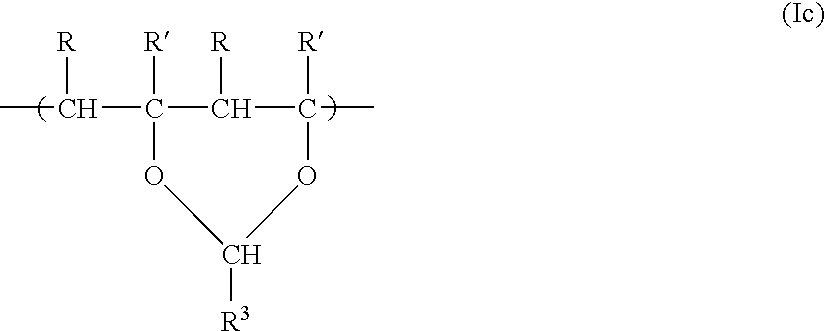Processing of positive-working lithographic printing plate precursor
- Summary
- Abstract
- Description
- Claims
- Application Information
AI Technical Summary
Benefits of technology
Problems solved by technology
Method used
Image
Examples
invention example 1
[0175]Imageable elements were prepared by the following procedure. A coating solution is prepared from the following components:
0.9020 gPolymer A0.1220 gLB9900 (49% in PM)0.0300 gInfrared dye S00940.0240 gCrystal Violet0.0240 gSudan Black0.1560 gDMABA0.0360 gPF 652 (10% in PM) 8.88 gPM 4.83 gMEK
[0176]The solution was filtered and applied to an electrochemically roughened and anodized aluminum substrate that was subjected to an after treatment using an aqueous solution of sodium phosphate / sodium fluoride by means of common methods and the coating is dried for 30 seconds at 80° C. in Glunz & Jensen “Unigraph Quartz” oven. The weight of the imageable layer was approx. 1.5 g / m2. The resulting imageable elements were conditioned with interleave paper for two days at 60° C. at RH of 28%.
[0177]The imageable element was exposed on a Kodak® Lotem 400 Quantum imager in a range of energies of 60 mJ / cm2 to 180 mJ / cm2 and developed for 30 seconds at 30° C. in a dish using the M-1 solution. After...
invention example 2
[0178]An imageable element was prepared as in Invention Example 1 but this time the imaged element was developed for 50 seconds at 26° C. in a dish using the gum M-2 solution. After washing the printing plate with water, it was evaluated for sensitivity (Clearing Point—lowest imaging energy at which the imaged regions are completely removed by the developer), Linearity Point (the energy at which the 50% dots at 200 lpi screen are reproduced as 50%±0.2% dots) and Cyan Density Loss in non-imaged regions. The results obtained for Invention Example 2 are shown below in TABLE I.
invention example 3
[0179]Imageable elements were prepared as described in Invention Example 1, but the following imageable layer coating solution was used:
0.9020 gPolymer A0.0300 gInfrared dye S00940.3500 gPig-951-B-180.0240 gSudan Black0.1560 gN-Phenylimino D.A.0.0360 gPF 652 (10% in PM) 8.88 gPM 4.83 gMEK
[0180]The imaged element was developed for 40 seconds at 30° C. in a dish using the M-3 solution. After washing the printing plate with water, it was evaluated for sensitivity (Clearing Point—lowest imaging energy at which the imaged regions are completely removed by the developer), Linearity Point (the energy at which the 50% dots at 200 lpi screen are reproduced as 50%±0.2% dots) and Cyan Density Loss in non-imaged regions. The results obtained for Invention Example 3 are shown below in TABLE I.
PUM
| Property | Measurement | Unit |
|---|---|---|
| Temperature | aaaaa | aaaaa |
| Percent by mass | aaaaa | aaaaa |
| Percent by mass | aaaaa | aaaaa |
Abstract
Description
Claims
Application Information
 Login to View More
Login to View More - R&D
- Intellectual Property
- Life Sciences
- Materials
- Tech Scout
- Unparalleled Data Quality
- Higher Quality Content
- 60% Fewer Hallucinations
Browse by: Latest US Patents, China's latest patents, Technical Efficacy Thesaurus, Application Domain, Technology Topic, Popular Technical Reports.
© 2025 PatSnap. All rights reserved.Legal|Privacy policy|Modern Slavery Act Transparency Statement|Sitemap|About US| Contact US: help@patsnap.com



